
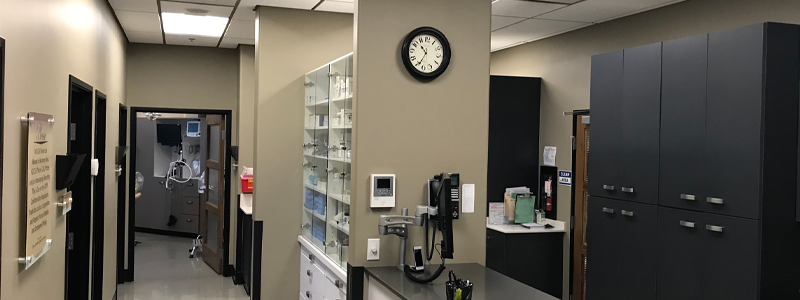
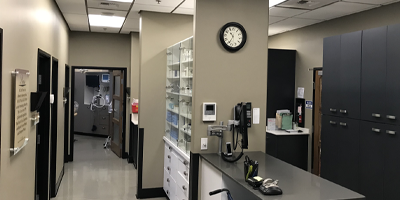
Oral Surgery
What is Bone Grafting?
Many times due to progressive disease, infection, or trauma, bone and soft tissue are lost in areas around the teeth. Bone resorption or deterioration occurs naturally when teeth are lost or removed unless dental implants are placed to preserve the bone.
Fortunately for those patients who have lost bone, it is possible to augment or replace the bone with grafting techniques and successfully place implants. Any defects in the bone in the front of the mouth can be corrected to create the proper facial contours and tissue support necessary to achieve optimal esthetic results.
If small defects are present in the desired implant location, a bone graft with either real or synthetic bone is used to fill in the defects. Since gum tissue grows faster than bone and will in essence invade the bone graft, causing it to shrink, a thin collagen membrane is used to cover the graft to prevent the gum tissue from growing into the area. Sometimes the bone graft can be accomplished at the same time as implant placement. This type of graft takes the same time to heal as it takes for the bone to remodel after the implants have been placed.
If there is a substantial amount of bone loss, which prevents the placement of dental implants, an actual block of bone can be removed from the chin or behind the lower back teeth and transplanted to the area in need. These “blocks” of bone are held in place using small titanium screws to allow for healing. They will often be covered with a thin collagen membrane to aid the healing process. These grafts typically require four to six months to heal and form new bone identical to the shape of the transplanted block. Implants can then be placed securely in this bone. It will usually take another three to four months for the bone to remodel around the implants.
- Sinus Lift Procedure: This procedure involves elevating the sinus membrane and placing the bone graft onto the sinus floor, allowing implants to be placed in the back part of the upper jaw.
- Ridge Expansion: The ridge expansion procedure, or ridge-split as it is nick-named, is another breakthrough procedure. When bone is lost in an area where a tooth or teeth are missing, implant placement can be difficult. This procedure separates the available bone and expands what is already there so that it will accept implant placement. In addition to being a workhorse procedure, it is far less painful than other bone grafting procedures. To make things even better the implant is placed at the same time as the expansion procedure. This decreases your in-office time and saves money over procedures that require multiple visits.

BONE GRAFTING SUPPLY, DYNA BLAST, IS USED TO INCREASE BONE VOLUMES
- Ridge-Augmentation: In severe cases, the ridge has been reabsorbed and a bone graft is placed to increase the ridge height and/or width.
- Platelet Releasing Growth Factor: In addition, Dr. Gray’s office has the newest breakthrough in bone grafting and implant stability, Platelet Releasing Growth Factor. A small volume of your blood is withdrawn. Using a centrifuge and micro-pipettes your Platelet Releasing Growth Factor is obtained, and placed into the surgical site. Studies have shown faster healing and statistically significant, improved 12-week implant stability. Platelet Releasing Growth factor, or PRGF, is one of the reasons that our immediate implant placement results are so good.
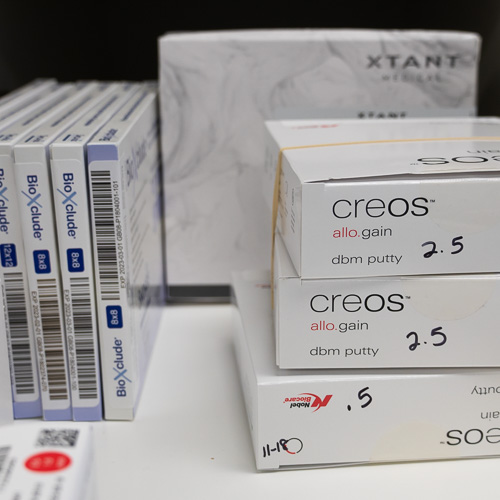
WE KEEP A CONSTANT STOCK OF HIGH QUALITY BONE GRAFTING MATERIALS
Surgical Removal of Teeth
Many simple extractions can be performed by a general dentist. However, since an oral surgeon has special training, dentists will usually refer patients for the removal of damaged, impacted, or severely decayed teeth, including wisdom teeth.
Patients who are considering dental implants are also referred to an oral surgeon so that the teeth can be removed with techniques that preserve the bone, which creates a better site for implant placement.
In addition, patients who would be more comfortable receiving sedation or general anesthesia during surgical procedures are usually referred to an oral surgeon for surgical removal of teeth.
Removal of Wisdom Teeth
Third molars are commonly referred to as wisdom teeth. The wisdom teeth are located in the back of the mouth, one in each quadrant behind the second or 12-year molars
Although most people develop 32 permanent teeth, often the jaws are not large enough to accommodate all four wisdom teeth. When inadequate space prevents the teeth from erupting into the proper position, they are “impacted”. An impacted tooth remains embedded in the gum tissue or bone beyond its normal eruption time (pushing through the gum tissue into place). Because they are the last teeth to emerge, the most common teeth to become impacted are the wisdom teeth, which normally emerge between the ages of 17 and 21.
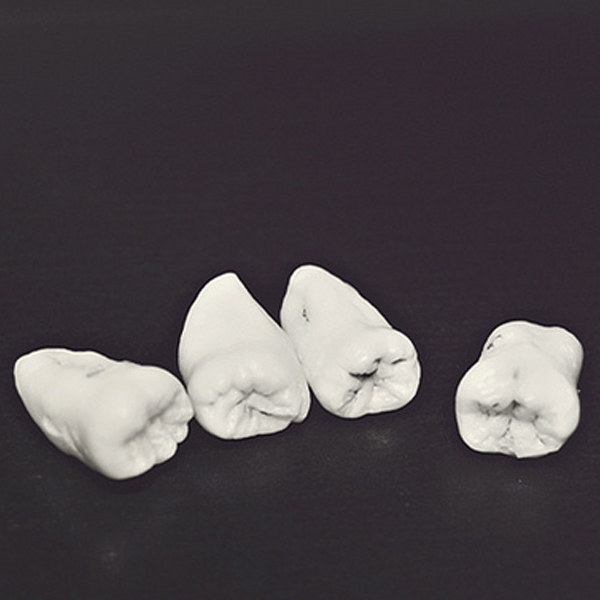
As the wisdom teeth develop, the roots continue to grow longer and the jawbone becomes denser. As people age, it becomes more difficult to remove the teeth and complications are more likely. In addition, the problems associated with impacted teeth tend to occur with increasing frequency after the age of 30. Therefore, it is usually recommended to have wisdom teeth removed during the teenage years or early twenties before the root structure is fully developed.
Some of the problems that can develop from partially impacted teeth include pain, infection, crowding, and damage to adjacent teeth. More serious problems, such as damage to the jawbone caused by the formation of cysts, can occur with completely impacted teeth. Surgeons generally recommend the removal of wisdom teeth to prevent these problems from developing.
Bone Preservation and Augmentation
Many times due to progressive disease, infection, or trauma, bone and soft tissues are lost in areas around the teeth. This process is accelerated when teeth are removed and nothing is done to replace the stimulation that tooth root provides to preserve the jawbone. This is extremely prevalent in the front of the upper jaw where bone loss and shrinking gum tissue can be seen when we smile.
Placement of dental implants prevents the defect that would normally develop when teeth are missing. And, there are techniques to replace bone and gum tissue in areas where it has been lost. Depending on the size of the defect, and the location within the mouth, this can be done easily in the office, often at the same time as placement of dental implants.
Patients who are considering dental implants are also referred to an oral surgeon so that the teeth can be removed with techniques that preserve the bone, which creates a better site for implant placement.
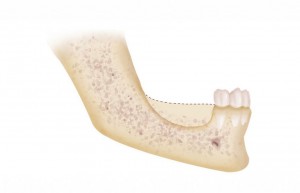
EXAMPLE OF BONE RESORPTION THAT OCCURS WHEN TEETH ARE MISSING
Anesthesia and Pain Relief
For your comfort, surgery can be performed under local anesthesia, fully awake; under general anesthesia, fully asleep; or with light sedation combined with local anesthesia. What method of treatment will work best for you is something that you and Dr. Gray will discuss at the consult appointment.
As part of his residency training, Dr. Gray worked as an anesthesia resident at Oregon Health and Science University, in Portland, Oregon. Our staff is highly trained and certified in outpatient anesthesia and our office has modern operating rooms equipped with state-of-the-art monitoring equipment to allow for safe anesthesia delivery.
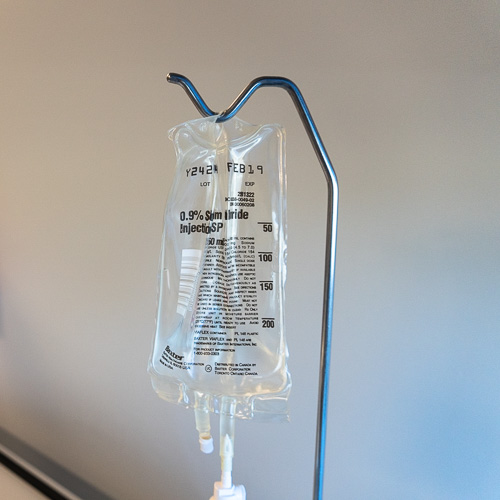
Dr. Gray is an Anesthesia Examiner for the Nevada State Board of Dental Examiners. In this role, he visits other offices that offer, or wish to offer anesthesia services. He ensures that the office has all of the emergency equipment required and that people on site know how to use the equipment. He reviews all the required medications to make sure that nothing is outdated, and that the person requesting an anesthesia license knows the proper doses and usage. Following this, he watches the doctor do surgery and then takes the doctor and staff through emergency scenarios. The surgeon being evaluated is questioned concerning 18 different emergency scenarios, as to what the surgeon’s response would be to different emergency situations.
Oral Diseases and Infections
The inside of the mouth is normally lined with a special type of skin (mucosa) that is smooth and coral-pink in color. Any alteration in this appearance could be a warning sign for a pathological process. The most serious of these is oral cancer.
These changes can be detected on the lips, cheeks, palate, and gum tissue around the teeth, tongue, face, and/or neck. Pain does not always occur with pathology and, curiously, is not often associated with oral cancer. However, any patient with facial or oral pain without an obvious cause may also be at risk for oral cancer. Cancer screening and biopsy of questionable tissue is a routine part of the practice. Fortunately, bones and soft tissues damaged by oral cancer can be repaired or reconstructed surgically. Dr. Gray also treats infections of the mouth, jaw and neck.
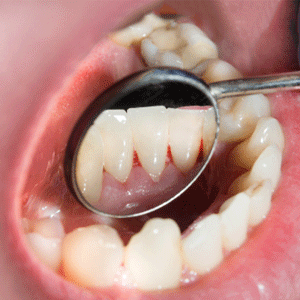
What is Bone Grafting?
Many times due to progressive disease, infection, or trauma, bone and soft tissue are lost in areas around the teeth. Bone resorption or deterioration occurs naturally when teeth are lost or removed unless dental implants are placed to preserve the bone.
Fortunately for those patients who have lost bone, it is possible to augment or replace the bone with grafting techniques and successfully place implants. Any defects in the bone in the front of the mouth can be corrected to create the proper facial contours and tissue support necessary to achieve optimal esthetic results.
If small defects are present in the desired implant location, a bone graft with either real or synthetic bone is used to fill in the defects. Since gum tissue grows faster than bone and will in essence invade the bone graft, causing it to shrink, a thin collagen membrane is used to cover the graft to prevent the gum tissue from growing into the area. Sometimes the bone graft can be accomplished at the same time as implant placement. This type of graft takes the same time to heal as it takes for the bone to remodel after the implants have been placed.
If there is a substantial amount of bone loss, which prevents the placement of dental implants, an actual block of bone can be removed from the chin or behind the lower back teeth and transplanted to the area in need. These “blocks” of bone are held in place using small titanium screws to allow for healing. They will often be covered with a thin collagen membrane to aid the healing process. These grafts typically require four to six months to heal and form new bone identical to the shape of the transplanted block. Implants can then be placed securely in this bone. It will usually take another three to four months for the bone to remodel around the implants.
- Sinus Lift Procedure: This procedure involves elevating the sinus membrane and placing the bone graft onto the sinus floor, allowing implants to be placed in the back part of the upper jaw.
- Ridge Expansion: The ridge expansion procedure, or ridge-split as it is nick-named, is another breakthrough procedure. When bone is lost in an area where a tooth or teeth are missing, implant placement can be difficult. This procedure separates the available bone and expands what is already there so that it will accept implant placement. In addition to being a workhorse procedure, it is far less painful than other bone grafting procedures. To make things even better the implant is placed at the same time as the expansion procedure. This decreases your in-office time and saves money over procedures that require multiple visits.

BONE GRAFTING SUPPLY, DYNA BLAST, IS USED TO INCREASE BONE VOLUMES
- Ridge-Augmentation: In severe cases, the ridge has been reabsorbed and a bone graft is placed to increase the ridge height and/or width.
- Platelet Releasing Growth Factor: In addition, Dr. Gray’s office has the newest breakthrough in bone grafting and implant stability, Platelet Releasing Growth Factor. A small volume of your blood is withdrawn. Using a centrifuge and micro-pipettes your Platelet Releasing Growth Factor is obtained, and placed into the surgical site. Studies have shown faster healing and statistically significant, improved 12-week implant stability. Platelet Releasing Growth factor, or PRGF, is one of the reasons that our immediate implant placement results are so good.

WE KEEP A CONSTANT STOCK OF HIGH QUALITY BONE GRAFTING MATERIALS
Surgical Removal of Teeth
Many simple extractions can be performed by a general dentist. However, since an oral surgeon has special training, dentists will usually refer patients for the removal of damaged, impacted, or severely decayed teeth, including wisdom teeth.
Patients who are considering dental implants are also referred to an oral surgeon so that the teeth can be removed with techniques that preserve the bone, which creates a better site for implant placement.
In addition, patients who would be more comfortable receiving sedation or general anesthesia during surgical procedures are usually referred to an oral surgeon for surgical removal of teeth.
Removal of Wisdom Teeth
Third molars are commonly referred to as wisdom teeth. The wisdom teeth are located in the back of the mouth, one in each quadrant behind the second or 12-year molars
Although most people develop 32 permanent teeth, often the jaws are not large enough to accommodate all four wisdom teeth. When inadequate space prevents the teeth from erupting into the proper position, they are “impacted”. An impacted tooth remains embedded in the gum tissue or bone beyond its normal eruption time (pushing through the gum tissue into place). Because they are the last teeth to emerge, the most common teeth to become impacted are the wisdom teeth, which normally emerge between the ages of 17 and 21.

As the wisdom teeth develop, the roots continue to grow longer and the jawbone becomes denser. As people age, it becomes more difficult to remove the teeth and complications are more likely. In addition, the problems associated with impacted teeth tend to occur with increasing frequency after the age of 30. Therefore, it is usually recommended to have wisdom teeth removed during the teenage years or early twenties before the root structure is fully developed.
Some of the problems that can develop from partially impacted teeth include pain, infection, crowding, and damage to adjacent teeth. More serious problems, such as damage to the jawbone caused by the formation of cysts, can occur with completely impacted teeth. Surgeons generally recommend the removal of wisdom teeth to prevent these problems from developing.
Bone Preservation and Augmentation
Many times due to progressive disease, infection, or trauma, bone and soft tissues are lost in areas around the teeth. This process is accelerated when teeth are removed and nothing is done to replace the stimulation that tooth root provides to preserve the jawbone. This is extremely prevalent in the front of the upper jaw where bone loss and shrinking gum tissue can be seen when we smile.
Placement of dental implants prevents the defect that would normally develop when teeth are missing. And, there are techniques to replace bone and gum tissue in areas where it has been lost. Depending on the size of the defect, and the location within the mouth, this can be done easily in the office, often at the same time as placement of dental implants.
Patients who are considering dental implants are also referred to an oral surgeon so that the teeth can be removed with techniques that preserve the bone, which creates a better site for implant placement.

EXAMPLE OF BONE RESORPTION THAT OCCURS WHEN TEETH ARE MISSING
Anesthesia and Pain Relief
For your comfort, surgery can be performed under local anesthesia, fully awake; under general anesthesia, fully asleep; or with light sedation combined with local anesthesia. What method of treatment will work best for you is something that you and Dr. Gray will discuss at the consult appointment.
As part of his residency training, Dr. Gray worked as an anesthesia resident at Oregon Health and Science University, in Portland, Oregon. Our staff is highly trained and certified in outpatient anesthesia and our office has modern operating rooms equipped with state-of-the-art monitoring equipment to allow for safe anesthesia delivery.

Dr. Gray is an Anesthesia Examiner for the Nevada State Board of Dental Examiners. In this role, he visits other offices that offer, or wish to offer anesthesia services. He ensures that the office has all of the emergency equipment required and that people on site know how to use the equipment. He reviews all the required medications to make sure that nothing is outdated, and that the person requesting an anesthesia license knows the proper doses and usage. Following this, he watches the doctor do surgery and then takes the doctor and staff through emergency scenarios. The surgeon being evaluated is questioned concerning 18 different emergency scenarios, as to what the surgeon’s response would be to different emergency situations.
Oral Diseases and Infections
The inside of the mouth is normally lined with a special type of skin (mucosa) that is smooth and coral-pink in color. Any alteration in this appearance could be a warning sign for a pathological process. The most serious of these is oral cancer.
These changes can be detected on the lips, cheeks, palate, and gum tissue around the teeth, tongue, face, and/or neck. Pain does not always occur with pathology and, curiously, is not often associated with oral cancer. However, any patient with facial or oral pain without an obvious cause may also be at risk for oral cancer. Cancer screening and biopsy of questionable tissue is a routine part of the practice. Fortunately, bones and soft tissues damaged by oral cancer can be repaired or reconstructed surgically. Dr. Gray also treats infections of the mouth, jaw and neck.


